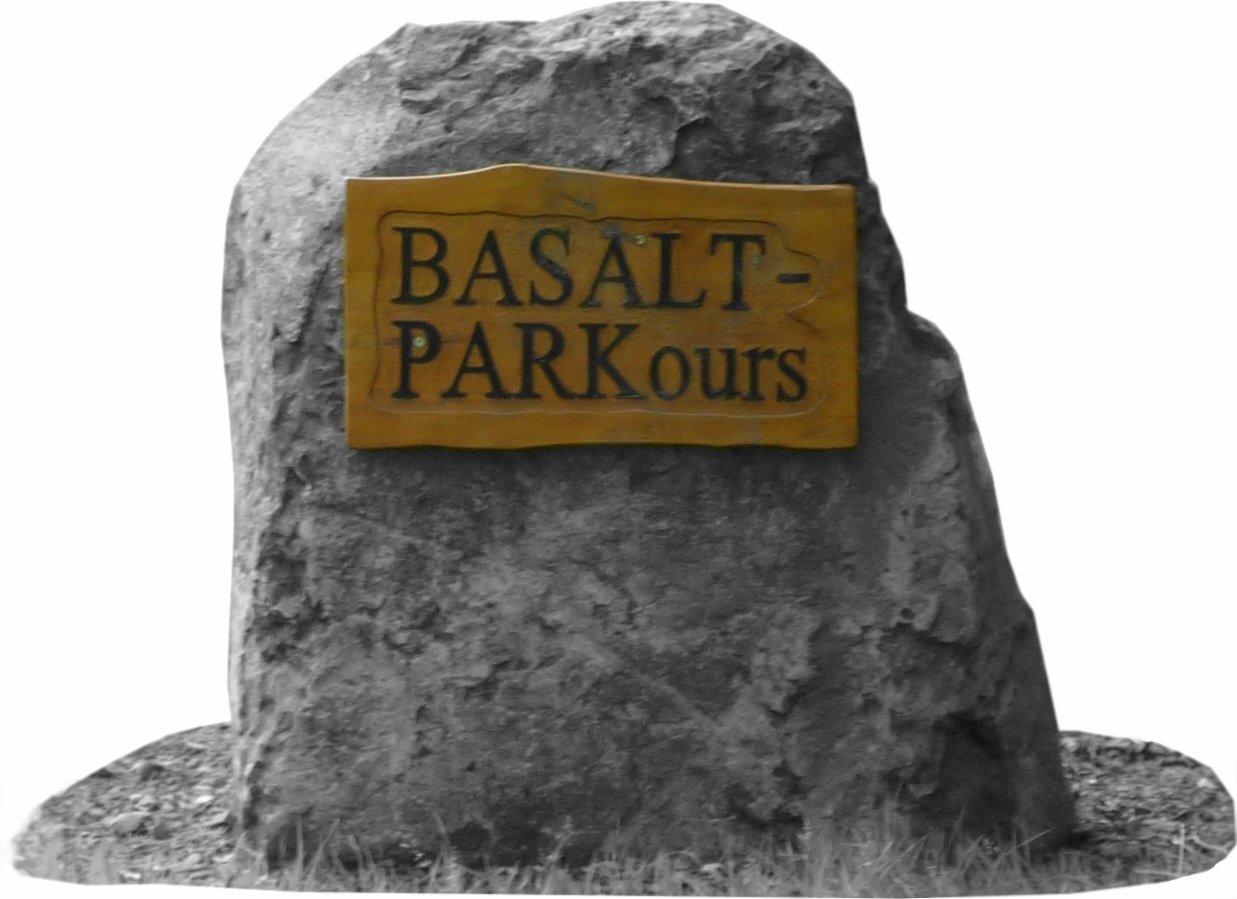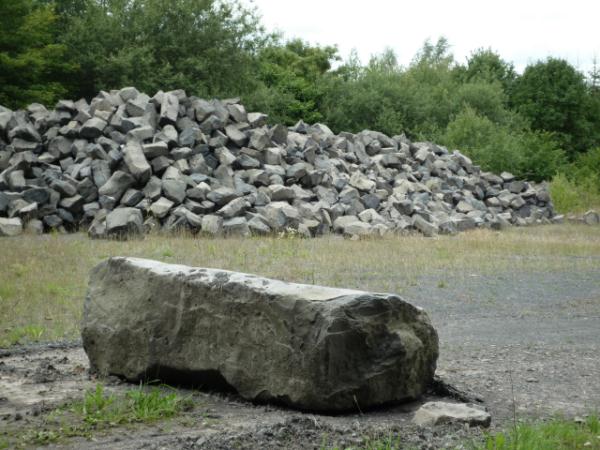jump to english description

In Beilstein spielte Basalt von jeher eine große Rolle, er sorgte für Arbeitsplätze und genügend Baumaterial.
Noch heute existieren drei aktive Steinbrüche die den Namen Beilstein in der ganzen Welt bekannt machen.
Basalt
Basalt zählt zu den magmatischen Gesteinen auch Erstarrungsgesteine genannt.
Diese Gesteine entstehen durch das Erkalten und Auskristallisieren von Magma.
Im Falle von Basalt tritt flüssiges Magma zu Tage und kühlt ab.
Bei der Abkühlung entstehen Schrumpfungsrisse, mit fortschreitendem Erkalten reißt das Gestein immer weiter und langsam entsteht die typische Säulenform.
An Randbereichen von Magmaaustritten findet man den eher runden Kugelbasalt.
Da Basalt Oberflächennah entsteht spricht man von Vulkanit oder Ergussgestein, bei unterirdischer Abkühlung von Plutonit oder Tiefengestein z.B. Granit.
Basalt ist ein basisches Gestein, das heißt es ist SiO2 arm, er besteht aus Eisen- und Magnesiumsilikaten mit Olivin, Pyroxen und calciumreichem Feldspat.
Basalt ist das weltweit am häufigsten vorkommende Gestein, sowohl auf dem Festland als auch unter Wasser.
Die meisten tieferen Ozeanböden bestehen aus Basalt der von jüngeren Sedimenten bedeckt ist.
Verwendung:
Basalt findet insbesondere bei Massivbauten Verwendung, die Burg Beilstein, die vom BasaltPARKours aus gut zu sehen ist, wurde komplett aus heimischem Basalt errichtet.
Kellergewölbe und Umgrenzungsmauern wurden ebenfalls aus Basalt gebaut.
Für Grabsteine, Bildhauerei und als Straßenunterbau findet der Basalt ebenfalls Verwendung.
Heute wird er hauptsächlich zur Deichbefestigung, Herstellung von Steinwolle und als Wegebelag verwendet.
Auch dekorativ, im Bereich der Landschaftsgärtnerei, findet der Basalt stetigen Zuspruch.

Um diesen Cache loggen zu dürfen solltet Ihr:
Ein Foto von eurem GPSr (wenn ihr wollt auch mit Euch) an einer Station des PARKours einstellen.
Einige Fragen beantworten:
Aus welchem Erdzeitalter stammt der ausgestellte Kugelbasalt?
Aus welchem Steinbruch stammt der als Mauer ausgestellte Basalt?
Wieviele cm misst der kleinste Säulenbasalt am Brunnen?
Schickt eure Antworten bitte mit eurem GC-Nickname im Betreff an VTler.
Ihr könnt dann sofort loggen, falls mit euren Antworten etwas nicht stimmt, melden wir uns bei euch.
Bitte vergesst nicht euer Foto dem Log hinzuzufügen.
english description

In Beilstein basalt was always very important it gives jobs and building material.
This very day, three quarrys are active and popularise the name Beilstein in the whole world.
Basalt
Basalt is counted among the magmatic rocks, it develops by the cool down and cristallization of magma.
In the case of basalt, the molten magma appears and cools down.
During the cool down, breaks arise because the material shrinks.
With the proceeding cooling down, the rock breaks further and further and the typical column form appears.
At the border area of magma emissions you can find the rare globe-basalt.
Because of the basalts developing near the surface, we call it volcanite or extrusive rock, if the cool down happens underground we call it plutonic rock, for example granite.
Basalt is a basic rock, that means it is poor in SiO2, it consists of iron- and magnesium silicate with olivine, pyroxene and feldspar rich on calcium.
Worldwide basalt is the most occuring rock on mainland as well as in the deep sea.
The most deeper grounds of the ocean consist of basalt which is covered with a relative thin layer of other sediments.
Usage:
Basalt is mostly used for massive buildings, the castle of Beilstein, that you can see from the PARKours is completely built of local basalt.
Even cellars and murals were built of this material.
For tombstones, sculpting and as basement for road construction it is used, too.
Today it is mainly used for fabrication of rock wool, for embankments and decorative in the landscaping.

You can log this cache as a found if you take a photo of your GPSr (maybe with yourself) somewhere in the basalt PARKours with one of the exhibits and you can answer the following questions:
1.From which geological era the globe-basalt comes from (Look for "Kugelbasalt" and "Erdzeitalter")?
2.From which quarry the basalt of the stone wall comes from (Look for "Mauerwerk" and "Fundort")?
3.How tall (in cm) is the smallest of the column-basalts in the fountain?
Send your reply to VTler.
Please enter your GC.com nickname in the subject of the mail.
Don't wait for log-permission, if your answers are not correct, we will contact you!